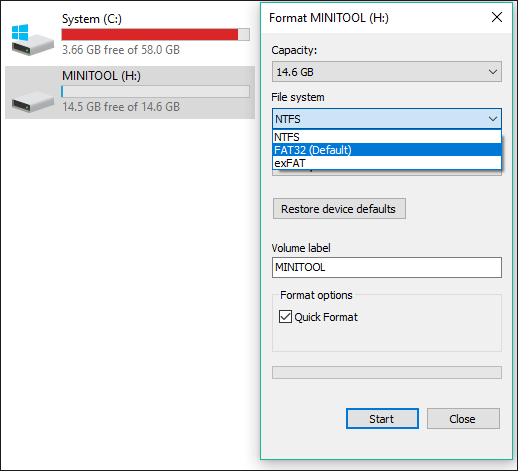exFAT is a file system which is created by Microsoft for flash drives. If you are both a Windows and a Mac OS user, you are probably familiar with exFAT, but if not, you may never have used this file system. Well, this article can help you to learn more information about it.
What Is exFAT?
exFAT is an acronym for Extended File Allocation Table which is a file system introduced by Microsoft in 2006. It is created to be used on flash memory like USB flash drives, SD cards and so on.
The name of exFAT gives a hint for its precursors: FAT file system. exFAT is a newer version of the FAT32 file system, and you can think it this way: it is a middle ground between FAT32 and NTFS file system (New Technology File System).
The Pros of exFAT
exFAT is a file system that is optimized for flash drives. For that purpose, exFAT has some of the main features that distinguish it from other file systems:
- exFAT is a lightweight file system that does not require maintenance of a large amount of hardware resources.
- It offers support for huge partitions, of up to 128 pebibytes, while 512 exbibytes is recommended.
- It supports huge file stored that is much larger than the 4GB limit imposed by FAT32. If you’re curious, the theoretical file size limit is 16 exbibytes, but this exceeds the maximum partition dimension, so the actual size limit of a file stored on exFAT is the same as the partition limit: 128 pebibytes.
- Cluster size up to 32MB.
- exFAT adopts the remaining space allocation table, the performance of remaining space allocation improved.
- The maximum number of files in the same directory can reach 2,796,202.
- exFAT is more compatible with a lot of devices and operating systems than NTFS.
The Cons of exFAT
exFAT lacks the support of journaling (in fact, to some extent it is not a disadvantage, and we will explain the reasons in the next part). The journaling feature allows the file system to keep records of the changes made to the files stored on it. This is useful when data corruption occurs because the logs can be used to recover corrupted data.
exFAT does not have this feature, which means that data can be more susceptible to corruption in the event of an unexpected shutdown or the inability to safely eject a removable drive formatted in this way.
Its file allocation tables and file allocations themselves do not support multi-user environments and are susceptible to large file fragmentation. Few other file systems have this issue.
It is not quite as widely-supported as FAT32 does.
What’s the Benefits When You Choose exFAT for A Removable Media
We take the USB flash drive as an example to explain this issue. First of all, we mentioned that exFAT is between FAT and NTFS. Though for performance it cannot compare to NTFS, it does have features better than FAT32 which you can find in the pros of exFAT(last part).
Here we list one typical point. The USB flash drive which is formatted with FAT32 file system cannot have a single file over 4GB. Although there are few opportunities for a single file to exceed 4GB, it does not mean that there are not: original files for BD/HD movies, uncompressed audio files for lossless music lovers, ISO files for DVDs, etc., if you want a full backup, you must choose exFAT over FAT32 as the storage format.
Then you might ask why not choose NTFS? Yes, NTFS is a more powerful file system, but it is targeted “log” file system requires frequent recording of disks during reading and writing, while a USB flash drive has a limit on the number of reading and writing, therefore, theoretically a USB flash drive which uses the NTFS format will have a relatively short lifetime. And the compatibility is a problem too.
What’s more? The exFAT file system is compatibility with both Windows and Mac, so if you want to transfer data between computers with these two different operating systems, formatting a USB flash drive with exFAT is the best choice.
In summary, if you want to format a USB flash drive but don’t know which file system to choose, here are the advices:
- It is generally recommended to use the FAT32 format, which has the greatest compatibility.
- If you want a better performance experience, want to store large files, or use the drive between Mac and Windows, you can choose the exFAT format (might not be recognized by some devices other than the computer).
- NTFS format is not recommended.

User Comments :